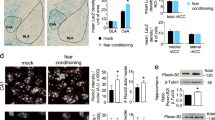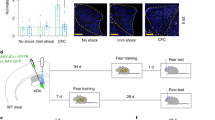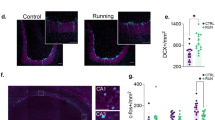Abstract
Memories become less precise and generalized over time as memory traces reorganize in hippocampal–cortical networks. Increased time-dependent loss of memory precision is characterized by an overgeneralization of fear in individuals with post-traumatic stress disorder (PTSD) or age-related cognitive impairments. In the hippocampal dentate gyrus (DG), memories are thought to be encoded by so-called 'engram-bearing' dentate granule cells (eDGCs). Here we show, using rodents, that contextual fear conditioning increases connectivity between eDGCs and inhibitory interneurons (INs) in the downstream hippocampal CA3 region. We identify actin-binding LIM protein 3 (ABLIM3) as a mossy-fiber-terminal-localized cytoskeletal factor whose levels decrease after learning. Downregulation of ABLIM3 expression in DGCs was sufficient to increase connectivity with CA3 stratum lucidum INs (SLINs), promote parvalbumin (PV)-expressing SLIN activation, enhance feedforward inhibition onto CA3 and maintain a fear memory engram in the DG over time. Furthermore, downregulation of ABLIM3 expression in DGCs conferred conditioned context-specific reactivation of memory traces in hippocampal–cortical and amygdalar networks and decreased fear memory generalization at remote (i.e., distal) time points. Consistent with the observation of age-related hyperactivity of CA3, learning failed to increase DGC–SLIN connectivity in 17-month-old mice, whereas downregulation of ABLIM3 expression was sufficient to restore DGC–SLIN connectivity, increase PV+ SLIN activation and improve the precision of remote memories. These studies exemplify a connectivity-based strategy that targets a molecular brake of feedforward inhibition in DG–CA3 and may be harnessed to decrease time-dependent memory generalization in individuals with PTSD and improve memory precision in aging individuals.
This is a preview of subscription content, access via your institution
Access options
Access Nature and 54 other Nature Portfolio journals
Get Nature+, our best-value online-access subscription
$29.99 / 30 days
cancel any time
Subscribe to this journal
Receive 12 print issues and online access
$209.00 per year
only $17.42 per issue
Buy this article
- Purchase on Springer Link
- Instant access to full article PDF
Prices may be subject to local taxes which are calculated during checkout






Similar content being viewed by others
References
Jasnow, A.M., Lynch, J.F. III., Gilman, T.L. & Riccio, D.C. Perspectives on fear generalization and its implications for emotional disorders. J. Neurosci. Res. 95, 821–835 (2017).
Biedenkapp, J.C. & Rudy, J. W. Context pre-exposure prevents forgetting of a contextual fear memory: implication for regional changes in brain activation patterns associated with recent and remote memory tests. Learn. Mem. 14, 200–203 (2007).
Wiltgen, B.J. & Silva, A.J. Memory for context becomes less specific with time. Learn. Mem. 14, 313–317 (2007).
Poulos, A.M. et al. Conditioning- and time-dependent increases in context fear and generalization. Learn. Mem. 23, 379–385 (2016).
Besnard, A. & Sahay, A. Adult hippocampal neurogenesis, fear generalization and stress. Neuropsychopharmacology 41, 24–44 (2016).
Liberzon, I. & Abelson, J.L. Context processing and the neurobiology of post-traumatic stress disorder. Neuron 92, 14–30 (2016).
Jovanovic, T. & Ressler, K.J. How the neurocircuitry and genetics of fear inhibition may inform our understanding of PTSD. Am. J. Psychiatry 167, 648–662 (2010).
Leal, S.L. & Yassa, M.A. Neurocognitive aging and the hippocampus across species. Trends Neurosci. 38, 800–812 (2015).
Bakker, A. et al. Reduction of hippocampal hyperactivity improves cognition in amnestic mild cognitive impairment. Neuron 74, 467–474 (2012).
Xu, W. & Südhof, T.C. A neural circuit for memory specificity and generalization. Science 339, 1290–1295 (2013).
Ruediger, S. et al. Learning-related feedforward inhibitory connectivity growth required for memory precision. Nature 473, 514–518 (2011).
Kheirbek, M.A., Klemenhagen, K.C., Sahay, A. & Hen, R. Neurogenesis and generalization: a new approach to stratify and treat anxiety disorders. Nat. Neurosci. 15, 1613–1620 (2012).
Likhtik, E., Stujenske, J.M., Topiwala, M.A., Harris, A.Z. & Gordon, J.A. Prefrontal entrainment of amygdala activity signals safety in learned fear and innate anxiety. Nat. Neurosci. 17, 106–113 (2014).
Jones, G.L. et al. A genetic link between discriminative fear coding by the lateral amygdala, dopamine and fear generalization. eLife 4, e08969 (2015).
Lynch, J.F., Winiecki, P., Gilman, T.L., Adkins, J.M. & Jasnow, A.M. Hippocampal GABAB(1a) receptors constrain generalized contextual fear. Neuropsychopharmacology 42, 914–924 (2017).
McClelland, J.L., McNaughton, B.L. & O'Reilly, R.C. Why there are complementary learning systems in the hippocampus and neocortex: insights from the successes and failures of connectionist models of learning and memory. Psychol. Rev. 102, 419–457 (1995).
Frankland, P.W. & Bontempi, B. The organization of recent and remote memories. Nat. Rev. Neurosci. 6, 119–130 (2005).
Winocur, G., Moscovitch, M. & Sekeres, M. Memory consolidation or transformation: context manipulation and hippocampal representations of memory. Nat. Neurosci. 10, 555–557 (2007).
Wiltgen, B.J. et al. The hippocampus plays a selective role in the retrieval of detailed contextual memories. Curr. Biol. 20, 1336–1344 (2010).
Winocur, G., Moscovitch, M. & Bontempi, B. Memory formation and long-term retention in humans and animals: convergence towards a transformation account of hippocampal–neocortical interactions. Neuropsychologia 48, 2339–2356 (2010).
Teyler, T.J. & Rudy, J.W. The hippocampal indexing theory and episodic memory: updating the index. Hippocampus 17, 1158–1169 (2007).
Hardt, O., Nader, K. & Nadel, L. Decay happens: the role of active forgetting in memory. Trends Cogn. Sci. 17, 111–120 (2013).
Frankland, P.W., Bontempi, B., Talton, L.E., Kaczmarek, L. & Silva, A.J. The involvement of the anterior cingulate cortex in remote contextual fear memory. Science 304, 881–883 (2004).
Liu, X. et al. Identification and manipulation of memory engram cells. Cold Spring Harb. Symp. Quant. Biol. 79, 59–65 (2014).
Kitamura, T. et al. Engrams and circuits crucial for systems consolidation of a memory. Science 356, 73–78 (2017).
Acsády, L., Kamondi, A., Sík, A., Freund, T. & Buzsáki, G. GABAergic cells are the major postsynaptic targets of mossy fibers in the rat hippocampus. J. Neurosci. 18, 3386–3403 (1998).
Martin, E.A. et al. The intellectual disability gene Kirrel3 regulates target-specific mossy fiber synapse development in the hippocampus. eLife 4, e09395 (2015).
Torborg, C.L., Nakashiba, T., Tonegawa, S. & McBain, C.J. Control of CA3 output by feedforward inhibition despite developmental changes in the excitation–inhibition balance. J. Neurosci. 30, 15628–15637 (2010).
Mori, M., Abegg, M.H., Gähwiler, B.H. & Gerber, U. A frequency-dependent switch from inhibition to excitation in a hippocampal unitary circuit. Nature 431, 453–456 (2004).
Porro, F. et al. β-adducin (Add2) KO mice show synaptic plasticity, motor coordination and behavioral deficits accompanied by changes in the expression and phosphorylation levels of the α- and γ-adducin subunits. Genes Brain Behav. 9, 84–96 (2010).
Rabenstein, R.L. et al. Impaired synaptic plasticity and learning in mice lacking β-adducin, an actin-regulating protein. J. Neurosci. 25, 2138–2145 (2005).
Buzsáki, G. Hippocampal sharp wave-ripple: a cognitive biomarker for episodic memory and planning. Hippocampus 25, 1073–1188 (2015).
Gan, J. et al. Phase-locked inhibition, but not excitation, underlies hippocampal ripple oscillations in awake mice in vivo. Neuron 93, 308–314 (2017).
Jadhav, S.P., Kemere, C., German, P.W. & Frank, L.M. Awake hippocampal sharp-wave ripples support spatial memory. Science 336, 1454–1458 (2012).
Ognjanovski, N. et al. Parvalbumin-expressing interneurons coordinate hippocampal network dynamics required for memory consolidation. Nat. Commun. 8, 15039 (2017).
Nakashiba, T., Buhl, D.L., McHugh, T.J. & Tonegawa, S. Hippocampal CA3 output is crucial for ripple-associated reactivation and consolidation of memory. Neuron 62, 781–787 (2009).
Çaliskan, G. et al. Identification of parvalbumin interneurons as cellular substrate of fear memory persistence. Cereb. Cortex 26, 2325–2340 (2016).
Wilson, I.A., Ikonen, S., Gallagher, M., Eichenbaum, H. & Tanila, H. Age-associated alterations of hippocampal place cells are subregion specific. J. Neurosci. 25, 6877–6886 (2005).
Yassa, M.A. et al. Pattern separation deficits associated with increased hippocampal CA3 and dentate gyrus activity in nondemented older adults. Hippocampus 21, 968–979 (2011).
Simkin, D. et al. Aging-related hyperexcitability in CA3 pyramidal neurons is mediated by enhanced A-type K+ channel function and expression. J. Neurosci. 35, 13206–13218 (2015).
Thomé, A., Gray, D.T., Erickson, C.A., Lipa, P. & Barnes, C.A. Memory impairment in aged primates is associated with region-specific network dysfunction. Mol. Psychiatry 21, 1257–1262 (2016).
Villanueva-Castillo, C., Tecuatl, C., Herrera-López, G. & Galván, E.J. Aging-related impairments of hippocampal mossy fibers synapses on CA3 pyramidal cells. Neurobiol. Aging 49, 119–137 (2017).
Geinisman, Y., deToledo-Morrell, L., Morrell, F., Persina, I.S. & Rossi, M. Age-related loss of axospinous synapses formed by two afferent systems in the rat dentate gyrus as revealed by the unbiased stereological dissector technique. Hippocampus 2, 437–444 (1992).
Reijmers, L.G., Perkins, B.L., Matsuo, N. & Mayford, M. Localization of a stable neural correlate of associative memory. Science 317, 1230–1233 (2007).
Scobie, K.N. et al. Krüppel-like factor 9 is necessary for late-phase neuronal maturation in the developing dentate gyrus and during adult hippocampal neurogenesis. J. Neurosci. 29, 9875–9887 (2009).
Lundquist, E.A., Herman, R.K., Shaw, J.E. & Bargmann, C.I. UNC-115, a conserved protein with predicted LIM and actin-binding domains, mediates axon guidance in C. elegans. Neuron 21, 385–392 (1998).
Barrientos, T. et al. Two novel members of the ABLIM protein family, ABLIM-2 and -3, associate with STARS and directly bind F-actin. J. Biol. Chem. 282, 8393–8403 (2007).
Matsuda, M., Yamashita, J.K., Tsukita, S. & Furuse, M. ABLIM3 is a novel component of adherens junctions with actin-binding activity. Eur. J. Cell Biol. 89, 807–816 (2010).
Cao, J. et al. miR-129-3p controls cilia assembly by regulating CP110 and actin dynamics. Nat. Cell Biol. 14, 697–706 (2012).
Beier, K.T. et al. Anterograde or retrograde trans-synaptic labeling of CNS neurons with vesicular stomatitis virus vectors. Proc. Natl. Acad. Sci. USA 108, 15414–15419 (2011).
Kamiya, H., Shinozaki, H. & Yamamoto, C. Activation of metabotropic glutamate receptor type 2/3 suppresses transmission at rat hippocampal mossy fiber synapses. J. Physiol. (Lond.) 493, 447–455 (1996).
Liu, X. et al. Optogenetic stimulation of a hippocampal engram activates fear memory recall. Nature 484, 381–385 (2012).
Goshen, I. et al. Dynamics of retrieval strategies for remote memories. Cell 147, 678–689 (2011).
Vazdarjanova, A. & McGaugh, J.L. Basolateral amygdala is involved in modulating consolidation of memory for classical fear conditioning. J. Neurosci. 19, 6615–6622 (1999).
Redondo, R.L. et al. Bidirectional switch of the valence associated with a hippocampal contextual memory engram. Nature 513, 426–430 (2014).
Girardeau, G., Inema, I. & Buzsáki, G. Reactivations of emotional memory in the hippocampus–amygdala system during sleep. Nat. Neurosci. 20, 1634–1642 (2017).
Yang, C. & Svitkina, T. Filopodia initiation: focus on the Arp2–3 complex and formins. Cell Adh. Migr. 5, 402–408 (2011).
Mejillano, M.R. et al. Lamellipodial versus filopodial mode of the actin nanomachinery: pivotal role of the filament barbed end. Cell 118, 363–373 (2004).
Wilson, M.A. & McNaughton, B.L. Reactivation of hippocampal ensemble memories during sleep. Science 265, 676–679 (1994).
Bartos, M., Alle, H. & Vida, I. Role of microcircuit structure and input integration in hippocampal interneuron recruitment and plasticity. Neuropharmacology 60, 730–739 (2011).
Zhou, Z. et al. Brain-specific phosphorylation of MeCP2 regulates activity-dependent Bdnf transcription, dendritic growth and spine maturation. Neuron 52, 255–269 (2006).
Lois, C., Hong, E.J., Pease, S., Brown, E.J. & Baltimore, D. Germline transmission and tissue-specific expression of transgenes delivered by lentiviral vectors. Science 295, 868–872 (2002).
Drokhlyansky, E. et al. The brain parenchyma has a type I interferon response that can limit virus spread. Proc. Natl. Acad. Sci. USA 114, E95–E104 (2017).
McAvoy, K.M. et al. Modulating neuronal competition dynamics in the dentate gyrus to rejuvenate aging memory circuits. Neuron 91, 1356–1373 (2016).
Ikrar, T. et al. Adult neurogenesis modifies excitability of the dentate gyrus. Front. Neural Circuits 7, 204 (2013).
Acknowledgements
We wish to thank members of the Sahay lab for comments on the manuscript and the late N.J. Sahay for advice. We are thankful to S. Tonegawa (MIT) for the AAV9-tetO-ChR2 construct, M.E. Greenberg (Harvard Medical School) for the lentiviral pLLX vector, J. Rajagopal (MGH) for the HEK293T cells and S. Ramirez (Boston University) for the AAV9-tetO-ChR2-mCherry virus. L.Z. is supported by US National Institutes of Health (NIH) grant R01MH104450. C.C. is an investigator of the Howard Hughes Medical Institute. A.S. acknowledges support from the NIH Biobehavioral Research Awards for Innovative New Scientists (BRAINS; grant R01MH104175), the NIH–National Institute on Aging (NIA) grant R01AG048908, NIH grant 1R01MH111729, the Ellison Medical Foundation New Scholar in Aging, the Whitehall Foundation, an Inscopix Decode award, a NARSAD Independent Investigator Award, Ellison Family Philanthropic support, the Blue Guitar Fund, a Harvard Neurodiscovery Center–MADRC Center Pilot Grant award, and a Harvard Stem Cell Institute Development grant and HSCI seed grant. C.H. was supported by a 2016 HSCI Harvard Internship Program Award.
Author information
Authors and Affiliations
Contributions
N.G., M.E.S., C.H., M.T.K., P.L. and A.B. performed experiments; X.M. and C.L.C. contributed reagents; M.E.S. and L.S.Z. contributed to slice electrophysiology experiments and interpretation of the data; A.S. and N.G. co-developed the concept, analyzed data and wrote the manuscript; and A.S. conceived the project and supervised all aspects of the project.
Corresponding author
Ethics declarations
Competing interests
A.S. and N.G. are named co-inventors on a patent application (US 2016/0376588 A1, PCT/US 15/20540) relating to this study.
Supplementary information
Supplementary Figures
Supplementary Figures 1–12 (PDF 12200 kb)
Supplementary Table 1
Complete statistical analyses (XLS 210 kb)
Rights and permissions
About this article
Cite this article
Guo, N., Soden, M., Herber, C. et al. Dentate granule cell recruitment of feedforward inhibition governs engram maintenance and remote memory generalization. Nat Med 24, 438–449 (2018). https://doi.org/10.1038/nm.4491
Received:
Accepted:
Published:
Issue Date:
DOI: https://doi.org/10.1038/nm.4491
This article is cited by
-
Systems consolidation induces multiple memory engrams for a flexible recall strategy in observational fear memory in male mice
Nature Communications (2023)
-
Assessments of dentate gyrus function: discoveries and debates
Nature Reviews Neuroscience (2023)
-
Dysfunction of NRG1/ErbB4 Signaling in the Hippocampus Might Mediate Long-term Memory Decline After Systemic Inflammation
Molecular Neurobiology (2023)
-
The Role of the Dentate Gyrus in Mediating Hippocampal Functions: The Healthy Brain
Neuroscience and Behavioral Physiology (2023)
-
Forgetting as a form of adaptive engram cell plasticity
Nature Reviews Neuroscience (2022)



